drones

Congress is beginning to assert its oversight role in declaring war by examining drone attacks. Yet, in Congressional testimony yesterday, Assistant Defense Secretary Michael Sheehan said that the Pentagon sees no reason to seek additional Congressional authority for the strikes. The Washington Post reports:
“At this point we’re comfortable with the AUMF as it is currently structured,” Assistant Defense Secretary Michael Sheehan said of the Authorization for the Use of Military Force passed by Congress in 2001. “Right now . . . it serves its purpose,” he said.
“In my judgment,” Sheehan said in testimony before the Senate Armed Services Committee, “this is going to go on for quite a while, yes, beyond the second term of the president. . . . I think it’s at least 10 to 20 years.”
Read more here.
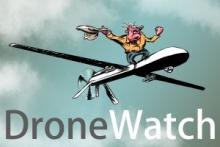
The U.S. Navy took a new step in drone warfare this morning. For the first time, a drone was launched from an aircraft carrier. The drone did not land back on the carrier, a feat that is challenging even for piloted aircraft, but that is expected soon. According to the Associated Press:
The Navy for the first time Tuesday launched an unmanned aircraft the size of a fighter jet from a warship in the Atlantic Ocean, as it wades deeper into America's drone program amid growing concerns over the legality of its escalating surveillance and lethal strikes.
The drone, called the X-47B, is considered particularly valuable because it's the first that is designed specifically to take off and land on an aircraft carrier, allowing it to be used around the world without needing the permission of other countries to serve as a home base.
Read more here.
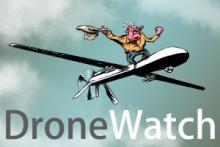
Nawaz Sharif, the newly elected prime minister of Pakistan told reporters yesterday that he considered U.S. drone attacks in that country a challenge to national sovereignty. According to the AP (via the San Jose Mercury News):
“The CIA's drone campaign targeting al-Qaida and other militants in the tribal regions has been extremely controversial in Pakistan, where people say it frequently kills innocent civilians -- something Washington denies -- and that it violates Pakistan's sovereignty.
"Drones indeed are challenging our sovereignty. Of course we have taken this matter up very seriously. I think this is a very serious issue, and our concern must be understood properly," said Sharif.”
Read more here.
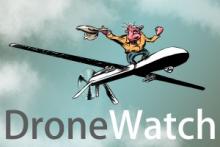
NPR ran a story today with an interview of a former Air Force drone pilot. He describes some of his experiences, including a death he believes was a child who ran into the target area at the last minute. It brought home to him “the reality of war. Good guys can die, bad guys can die, and innocents can die as well.”
You can listen to the interview here.
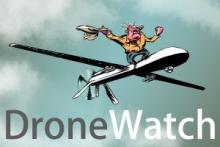
A Pakistani court has ruled that U.S. drone strikes in that country are illegal. The case was filed on behalf of the families of victims killed in a March 17, 2011 strike. The Independent (U.K.) reports:
In what activists said was an historic decision, the Peshawar High Court issued the verdict against the strikes by CIA-operated spy planes in response to four petitions that contended the attacks killed civilians and caused “collateral damage”.
Chief Justice Dost Muhammad Khan, who headed a two-judge bench that heard the petitions, ruled the drone strikes were illegal, inhumane and a violation of the UN charter on human rights. The court said the strikes must be declared a war crime as they killed innocent people.
Read more here.
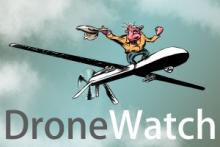
China is rapidly developing a fleet of drones, some of which are already patrolling its borders. The number of drones and their capabilities remains unknown, but other countries in the region are watching closely. The AP reports:
China's move into large-scale drone deployment displays its military's growing sophistication and could challenge U.S. military dominance in the Asia-Pacific. It also could elevate the threat to neighbors with territorial disputes with Beijing, including Vietnam, Japan, India and the Philippines. China says its drones are capable of carrying bombs and missiles as well as conducting reconnaissance, potentially turning them into offensive weapons in a border conflict.
China's increased use of drones also adds to concerns about the lack of internationally recognized standards for drone attacks. The United States has widely employed drones as a means of eliminating terror suspects in Pakistan and the Arabian Peninsula.
Read more here.
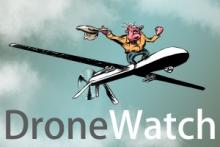
As the number of drone strikes against targets in Yemen has grown, the anger of the local people is also growing. The AP reports (via philly.com):
In its covert fight against al-Qaida in Yemen, the United States has dramatically stepped up its use of drone strikes the past year, scoring key successes against one of the most active branches of the terror network. With more than 40 strikes reported in 2012 and nine so far this year, Yemen has become the second biggest front in American drone warfare, after Pakistan.
But the escalation has meant more civilians getting caught in the crossfire.
Civilian deaths are breeding resentments on a local level, sometimes undermining U.S. efforts to turn the public against militants. The backlash is still not as large as in Pakistan, where there is heavy pressure on the government to force limits on strikes, but public calls for a halt to strikes are starting to emerge.
Read more here.
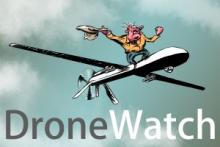
Lawrence Wilkerson, chief of staff to Secretary of State Colin Powell, reviews a new book in Al Jazeera — Akbar Ahmed's The Thistle and the Drone: How America's War on Terror Became a Global War on Tribal Islam.
In the Cold War, the US funded and supported any regime, dictatorship or democracy, that opposed communism. From US support for the cruel and brutal dictator in Cuba, Fulgencio Batista, to the Shah of Iran whose support by the US still haunts US-Iran relations, to the leader of Iraq whom the US first supported and then overthrew, Saddam Hussein, there was no virtue not sacrificed in the American quest to subvert and defeat communism. Today, that zeal - and the money and effort backing it - has morphed into US tactics to defeat terrorism.
Under the Obama administration, the principal instrument of these tactics is the drone. Professor Ahmed's book provides a searing indictment of the use of that instrument.
Read more here.

A hunger strike by detainees has Guantánamo back in the news. But has the Obama administration been using drone strikes to kill al Qaida suspects rather than capturing them? The attorney who wrote the the first legal justification for using drones thinks so. The Guardian reports:
“John Bellinger, who was responsible for drafting the legal framework for targeted drone killings while working for George W Bush after 9/11, said he believed their use had increased since because President Obama was unwilling to deal with the consequences of jailing suspected al-Qaida members.
"This government has decided that instead of detaining members of al-Qaida [at Guantánamo] they are going to kill them," he told a conference at the Bipartisan Policy Center.”
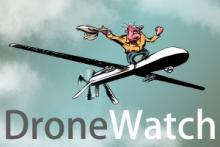
This weekend saw protests on both sides of the Atlantic against drone killings.
In the U.S., more than 250 people marched on an Air National Guard Base at Hancock Field in Syracuse, N.Y. At the end of a funeral procession, 30 people were arrested at the gates of the base. According to the Syracuse Post-Standard:
“Protesters pounded drums, chanted and carried mock coffins. A baby doll smeared with fake blood was suspended from a tall poll carried by one protestor. A sheriff’s deputy speaking through a bullhorn warned protesters laying on the driveway in front of the gate to get up off the ground or face arrest for disorderly conduct. After they refused, the protesters were handcuffed and escorted to a Sheriff’s Department van.”
The protest was organized by the Upstate NY Coalition to Ground the Drones & End the Wars.
In the U.K., 700 people participated in a demonstration outside a Royal Air Force base north of London to protest the U.K.'s use of armed drones in Afghanistan. The action came two days after the news that the Royal Air Force had begun flying drones from the Waddington Base. CNN reported:
"People are pretty upset about the idea that Britain will be developing this drone warfare," said John Hilary, executive director of War on Want. … The coalition also includes members of the Campaign for Nuclear Disarmament, the Drone Campaign Network and Stop the War Coalition.”
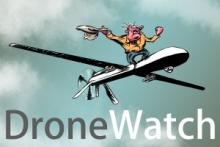
The U.S.-Mexico border is currently patrolled by 10 Predator surveillance drones. The immigration reform bill introduced in the Senate would increase that in order to provide constant coverage. ABC/Univision reported:
“Unmanned aerial vehicles, or drones, could soon be patrolling the United States border with Mexico 24 hours a day, seven days a week. That's what the major immigration reform bill introduced last week by a bipartisan group of senators proposes.
“The goal: 'effective control' of the border. Under the bill, no immigrant granted provisional legal status would be eligible to apply for a Green Card until the Department of Homeland Security shows it's made substantial progress toward that goal. Border hawks want the pathway to citizenship more firmly tied to border security success.”
But, as Common Dreams reports:
“As the new immigration reform bill moving through the US Senate puts aerial drones at the center of a beefed-up militarized approach to border security, a new report shows that the existing drone-border program has proved an 'inefficient, costly and absurd approach' to monitoring the border or enforcing current immigration laws.”
The report was produced by the Center for International Policy, you can read it at Drones over the Homeland.
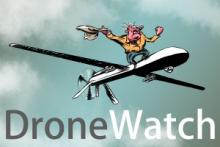
The British military has been flying drones in Afghanistan for several years, firing 350 weapons, including Hellfire missiles. But due to lack of the necessary capacity, British pilots have controlled them from the U.S. Creech Air Force base in Nevada. Last week that changed, as the Guardian reports:
“Remotely controlled armed drones used to target insurgents in Afghanistan have been operated from the UK for the first time, the Ministry of Defence said on Thursday. Missions of the missile-carrying Reaper aircraft began from a newly built headquarters at RAF Waddington in Lincolnshire earlier this week – five years after the MoD bought the unmanned aerial vehicles (UAVs) to monitor and attack the Taliban”.
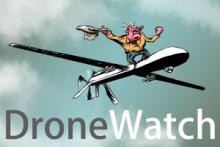
An Israeli jet shot down a drone off its northern coast on Thursday. While some Israeli officials said they believed it was an Iranian-manufactured aircraft sent by Hezbollah, that group denied it. The Associated Press reported:
Israeli military spokesman Lt. Col. Peter Lerner said the unmanned aircraft was detected as it was flying over Lebanon and tracked as it approached Israeli airspace.
He said the military waited for the aircraft to enter Israeli airspace, confirmed it was “enemy,” and then an F-16 warplane shot it down, smashing its wreckage into the sea about five miles (eight kilometers) off the northern port of Haifa. Lerner said Israeli naval forces were searching for the remains of the aircraft.
He said it still was not clear who sent the drone, noting it flew over Lebanese airspace, but that it could have originated from somewhere else.

The Senate Judiciary Subcommittee on the Constitution, Civil Rights, and Human Rights, chaired by Sen. Dick Durbin (D-Ill.), held a hearing yesterday on “The Constitutional and Counterterrorism Implications of Targeted Killing.” It was the Senate’s first public hearing on drones. McClatchy News reported on the hearing that witnesses urged “the Obama administration to make public more information about its top-secret targeted killing program amid questions about the legality and effectiveness of hundreds of CIA drone strikes in Pakistan and elsewhere.”
One witness was from Yemen:
“Farea al Muslimi, a U.S.-educated activist from Yemen, testified that drone strikes have killed many civilians in his country, aiding al Qaida’s regional affiliate, al Qaida in the Arabian Peninsula, by appearing to affirm its propaganda that the United States is waging war against ordinary Yemenis. “The drones have simply made more mistakes than AQAP has ever done,” he said.”
Another witness, retired Marine Gen. James Cartwright, former vice chairman of the Joint Chiefs, had some practical proposals:
“Cartwright called on Obama to establish a government task force to evaluate secret drone strikes, including the extent of civilian casualties and their impacts on communities; the effectiveness of precautions used to avert such casualties; and the means by which the results of strikes are assessed. An unclassified version of the task force’s final report should be made public, he said.
“Cartwright said the CIA also should publicly acknowledge its role in drone operations outside Afghanistan, establish procedures for declassifying information on those operations after they’re over, and provide information to Congress on the impact of drone strikes on civilians.”
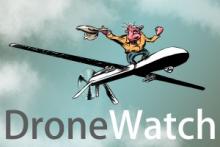
The Senate Judiciary Subcommittee on the Constitution, Civil Rights, and Human Rights is holding a hearing this afternoon on “The Constitutional and Counterterrorism Implications of Targeted Killing.” According to Subcommittee Chair Sen. Richard Durbin’s office:
“the hearing will address the legal and policy issues raised by drone strikes, including the constitutional and statutory authority for targeted killings, the scope of the battlefield in the conflict with Al Qaeda and associated forces, and the international precedent set by U.S. drone policy.”
You can watch it live here.

The month-long break in drone strikes appears to have ended.
On Wednesday, a strike on a training camp in Pakistan killed at least five people. According to Al Jazeera:
“A US drone has fired two missiles into a Taliban training camp in Pakistan, destroying the compound and killing at least five people, local officials have said.“Wednesday's strike took place in the Baber Ghar area of the South Waziristan tribal district on the Afghan border, a stronghold of Pakistani Taliban leader Hakimullah Mehsud where the faction runs several camps.”
Also on Wednesday, two separate strikes in Yemen killed five. The Associated Press reported:
“Two U.S. drone strikes Wednesday killed at least five suspected al-Qaida militants and destroyed the house of one of them in a mountainous area south of the capital, Sanaa, a Yemeni security official and witnesses said.
“The four were killed in the first strike while riding a vehicle in the desert area of Oussab al-Ali, about 140 kilometers (90 miles) south of Sanaa, the official said. The second strike killed a fifth suspected jihadi, Hamed Radman. A drone bombed his house, the official said.”
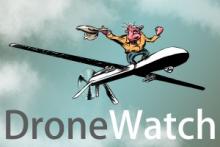
Ten major human rights and civil rights organizations have sent a statement to President Obama expressing their “shared concerns” about the U.S. targeted killing program using drones. The signatories included the American Civil Liberties Union, Amnesty International, the Center for Constitutional Rights, Human Rights Watch, and others.
The statement begins by summarizing the organizations’ concerns, and then elaborates on each point.
“The undersigned human rights and civil rights groups urge the United States to take essential steps to ensure meaningful transparency and legal compliance with regard to U.S. targeted killing policies and practices, particularly those outside the internationally-recognized armed conflict in Afghanistan. In particular, we call on the administration to: publicly disclose key targeted killing standards and criteria; ensure that U.S. lethal force operations abroad comply with international law; enable meaningful congressional oversight and judicial review; and ensure effective investigations, tracking and response to civilian harm."

On Sunday evening, the first U.S. drone attack in nearly a month killed at least four people in Pakistan. The attack took place in Datta Khel town, 22 miles west of Miranshah, the main town in the North Waziristan region. According to Agence France-Presse:
Six US drones flew over the area when one of them fired two missiles at a compound in the Manzarkhel area of the town. "The drones kept hovering at the compound for a while and then one drone fired two missiles at the time of sunset," a local security official said. "At least four militants were killed in the strike," said the official.

After years of secrecy, the leaks of classified information on the drone killing program in Pakistan have turned into a torrent. Today, it was the McClatchy Newspapers, running two stories by national security and intelligence reporter Jonathan S. Landay.
The first examines in depth intelligence reports that covered most of the drone strikes in 2006-2008 and 2010-2011. Reviewing the killings covered in these reports, Landay concludes that:
“Contrary to assurances it has deployed U.S. drones only against known senior leaders of al Qaida and allied groups, the Obama administration has targeted and killed hundreds of suspected lower-level Afghan, Pakistani and unidentified “other” militants in scores of strikes in Pakistan’s rugged tribal area, classified U.S. intelligence reports show.”
The second, apparently using some of the same reports, reveals the history and extent of cooperation between the CIA and Pakistani intelligence. While Pakistan was aiding the U.S against al Qaida, CIA drones were aiding the Pakistani military against the Taliban.
“Even as its civilian leaders publicly decried U.S. drone attacks as breaches of sovereignty and international law, Pakistan’s premier intelligence agency secretly worked for years with the CIA on strikes that killed Pakistani insurgent leaders and scores of suspected lower-level fighters, according to classified U.S. intelligence reports. Dozens of civilians also reportedly died in the strikes in the semi-autonomous tribal region of Pakistan bordering Afghanistan that is a stronghold of al Qaida, Afghan militants, other foreign jihadists and a tangle of violent Pakistani Islamist groups.”
Both stories are long, both are well worth reading. Taken together, they reveal more secret details of the drone killing program.

While there appears to be a lull in drone attacks in Pakistan and Yemen, are the next targets being prepared?
The Japan Times reports that as tensions on the Korean Peninsula remain high, the possibility of unarmed drones carrying out surveillance over North Korea is increasing.
“Japan and the U.S. might deploy the Global Hawk, a high-altitude reconnaissance drone, at Misawa Air Base in Aomori Prefecture to increase surveillance of North Korea … Interest in monitoring North Korea has been climbing since it began threatening nuclear strikes, and reportedly moved a midrange missile to its east coast Thursday.”
The Voice of America reported a confirmation of the story,
“The Defense Ministry in Tokyo also confirms the United States is considering deploying high altitude aerial reconnaissance "Global Hawk" drones to Misawa air base in northern Japan to monitor North Korea.”
While the Global Hawk is not designed to carry weapons, its surveillance capabilities have made it “one of the best sources of tips for where to send the Predator and Reaper drones, which fly at lower altitudes and fire missiles.” Is that what’s in store for North Korea?